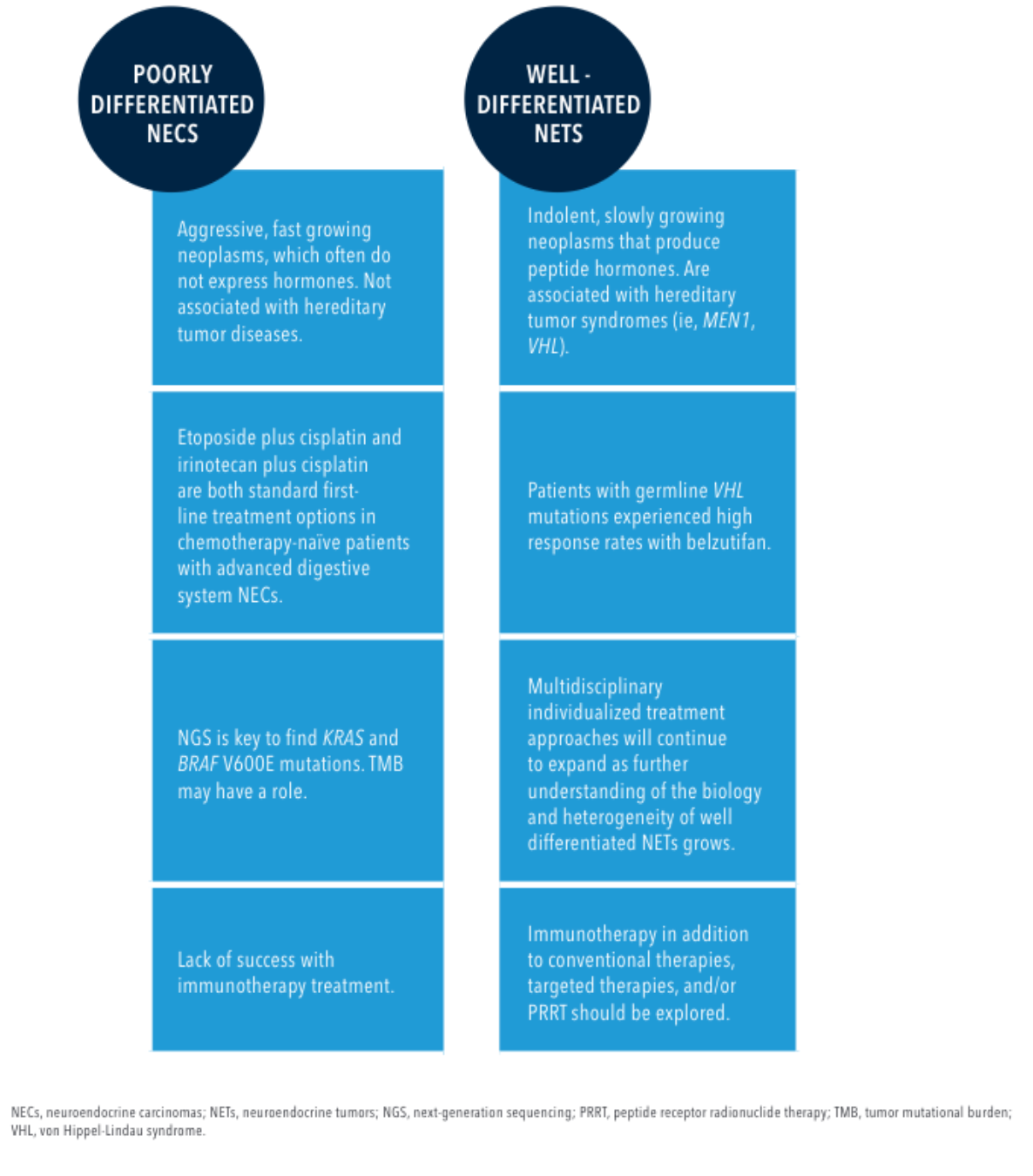Article
Sequencing Strategies, Improving QOL Are Top Priorities in Neuroendocrine Neoplasm Treatment
Author(s):
Diane Reidy-Lagunes, MD, discussed the role of next-generation sequencing paired with systemic therapies and the option of peptide receptor radionuclide therapy in neuroendocrine malignancies.
Diane Reidy-Lagunes, MD

With a treatment paradigm that is burgeoning with research as well as unanswered questions, neuroendocrine neoplasm experts are focused on determining optimal treatment sequences and improving quality of life (QOL) for both poorly differentiated and well-differentiated subsets. Additionally, investigators continue to seek to the role, if any, of immunotherapies and other personalized approaches in an evolving space.
“We have been so excited that the treatment landscape continues to broaden,” Diane Reidy-Lagunes, MD, said in an interview with OncLive®. “We have several lines of therapies, including locoregional approaches as well as systemic therapies.”
Reidy-Lagunes, a medical oncologist at Memorial Sloan Kettering Cancer Center in New York, New York, will serve as the moderator of the Gastrointestinal (GI) Cancers track at the 40th Annual Chemotherapy Foundation Symposium® (CFS®). In an interview with OncLive®, she spoke on her upcoming presentation, “Approach to Neuroendocrine Malignancies in 2022,” which will feature topics including the role of next-generation sequencing (NGS) paired with systemic therapies and the option of peptide receptor radionuclide therapy (PRRT).
What recent data have led to a shift in sequencing strategies for patients with poorly differentiated GI neuroendocrine carcinomas (NECs)?
Starting with poorly differentiated NECs, there are a couple of recent findings that are important. [First,] the Japanese [TOPIC-NEC] study showed cisplatin and etoposide vs cisplatin/irinotecan were essentially equivalent for patients with GI NECs. That is important, in that both of those therapies are often used and can be considered depending on the toxicity profile and the patient you’re treating [Figure1-6].
Figure. Poorly Differentiated NECs vs Well-Differentiated NETs1-6

In addition to that, recent data suggest NGS for poorly differentiated NECs can be very important. We are finding more BRAF mutations in colorectal NECs, for example, and that’s because the natural history of NECs is that they’re likely adenocarcinomas gone awry. With a colorectal NEC, we may see BRAF V600E mutations, you may see KRAS, [and], importantly, some of those may in fact be targetable.
The importance of NGS is something that we will be talking about in poorly differentiated NECs in addition to systemic therapies. Immunotherapy has been tried in that patient population, but unfortunately, with not enough success.
What have been some of the changes seen in treatment decisions for patients with well differentiated neuroendocrine tumors (NETs)?
In well-differentiated NETs, there are opportunities for patients with germline mutations, specifically for VHL [Von Hippel-Lindau syndrome]. Belzutifan [Welireg] was recently approved by the FDA for patients with a germline VHL mutation, and response rates were very high. Many of us will use that when we need it [for] a patient with very stable disease [and it’s] less likely to be as important of a drug if they’re otherwise asymptomatic and don’t necessarily need treatment right away.
There are lots of opportunities to try to go a little more granularly as we are understanding the biology and heterogeneity of these tumors so that we can better define and personalize the approach for our patients. Unfortunately, sequencing has been a challenge in part because we just don’t have randomized data to help us know for sure what should be considered.
[In] the Netter-1 study [NCT01578239], patients received octreotide prior to PRRT. That’s 1 example in knowing that, in general, first-line therapies are somatostatin analogues for systemic approaches followed by PRRT, if that’s an option.
Should real-world data be used in combination with clinical trials to inform treatment recommendations?
Because we don’t have prospective randomized data, we’re trying to the best of our ability to use [information from] databases to look at how well [these patients fared]. Are there opportunities to learn from those patient populations and those databases to say, based on these best available data, [do] patients who received X vs Y seem to do better or not?
I’m an advocate for trying our best to get some sort of data with a caveat that if it’s not randomized, we must be very careful [about] how we interpret it. At the very least, it’s hypothesis generating and can be very helpful. [However,] in 2022, we’re saying that most therapies we choose in sequencing have to do with the biology of the tumor [and] asking, is [the tumor growing] fast or slow?
Traditionally cytotoxic therapies are used for patients with a higher burden of disease or if the tumor is growing at a faster pace. However, targeted therapies [such as] mTOR and VEGF inhibitors can and should be considered in patients with slower-growing tumors. Whether higher-grade tumors can also benefit from [this approach] is where it’s less clear [and] we often try to use chemotherapies first.
Is there a role for immunotherapies in combination with other agents to achieve improved responses?
Traditional markers that we could use—microsatellite-instability high or high tumor mutational burden [TMB], which is [used as a marker for] FDA indications—is something that we absolutely would still want to try in NECs. Unfortunately, [these markers are not as common] as we would like to see in terms of the number of patients who have high TMB, but the exception is in poorly differentiated NECs. TMB should be considered [for testing], particularly with the poorly differentiated NECs.
For the well-differentiated NETs, there have been lots of concepts [under consideration for] potentially [combining] immunotherapy plus some of the targeted therapies and/or PRRT. We don’t have data on that yet. When the single-agent activity is very little, how much incremental benefit will there be by adding [immunotherapy] to a therapy that’s already known?
In low-grade tumors, particularly small bowel tumors, there’s not as much excitement about adding immunotherapy to therapies that would be active in that patient population. But perhaps in poorly differentiated, higher-grade, [or] foregut tumors [that] may be where the money is. For example, some atypical lung NETs do respond [to immunotherapy]. That is 1 opportunity [where] one could consider [a combination of immunotherapy] potentially with cytotoxics, but [it’s] not ready for prime time yet.
What unmet needs remain in this patient population?
We all feel strongly about value-based care; more and more we’re finding that the financial toxicities that our patients have to endure [must] be considered and we need to do better in recognizing that. As clinicians, we can start by asking, “How are you doing? Do you need social work support?” Recent data from Memorial Sloan Kettering Cancer Center show that it’s as high as 40% in a cancer center where generally we don’t ask [patients those questions]. That’s 1 area of unmet need: thinking carefully about what the costs will be for our patients needs to be considered.
Drug-related toxicities and QOL [are a second area of attention]. I always tell my patients that the most important thing I need to do in my job is to keep them with us for as long as possible and as well as possible. What are the therapies that can maintain a solid QOL? Sometimes when the cancer picks up its pace, we need to pull out therapies that may have more potential toxicities and be very careful in whatever we do from a shorter- and longer-term perspective.
[It’s important] that we’re trying to define what the [adverse] effects are, [know] how our patients are doing, [and] listening to them. Being able to have the right instruments to know that the therapies we’re providing do provide [an improvement in] QOL is going to be important. Every therapy that we have is supposed to be palliative; it’s supposed to stop the cancer from growing and spreading and allow patients to have a good QOL. If the drug itself is harder than the disease, then we’re not doing something right.
Lastly, in terms of efficacy and trying to better define what that optimal sequencing of therapies might be, is there a difference? My hunch is the difference is probably small in terms of which therapies we use first vs second vs third, but I don’t have data to show that. We owe it to our patients, and to science, to try our best to get the best science that we can to answer those questions. Importantly, we don’t want patients to get sick quickly and then not have all the therapies available to them. We need to make sure that we’re threading the needle carefully [to ensure] that our patients are being offered all these different therapies. This is also a challenge, but we want to make sure that we’re allowing our patients to get them.
What other lectures are you looking forward to hearing at this year’s CFS?
We have a lot of exciting GI talks [including topics such as] novel approaches to treatments and spectrums of biliary cancer. The FDA approvals for FGF2-mutant cholangiocarcinoma [futibatinib (Lytgobi) and infigratinib (Truseltiq)] will likely be discussed, as well as other therapies, including the addition of durvalumab [Imfinzi] to gemcitabine and cisplatin.
We then go into integrating and sequencing therapies for hepatocellular carcinoma. That is another landscape that has changed in the past couple of years in [a good] way. It can be a little bit daunting and overwhelming at times. [I’m] very excited to hear that talk and how to best categorize these different therapies and where best to put them for our patients.
We will talk about [circulating tumor] DNA, particularly in the adjuvant setting, in colon cancer and its role there as well as the potential to use it to [determine] therapies in the future for all GI cancers. We are going to talk about the neoadjuvant approach to rectal cancer with a very strong emphasis on QOL, [and which patients] may be able to be watched without a surgery. Lastly, we’ll have a very exciting debate on the role of first-line EGFR inhibitors in patients with metastatic colorectal cancer.
References
- Klöppel G. Neuroendocrine neoplasms: dichotomy, origin and classifications. Visc Med. 2017;33(5):324-330. doi:10.1159/000481390
- Morizane C, Machida N, Honma Y, et al. Effectiveness of etoposide and cisplatin vs irinotecan and cisplatin therapy for patients with advanced neuroendocrine carcinoma of the digestive system: the TOPIC-NEC phase 3 randomized clinical trial. JAMA Oncol. 2022;8(10):1447-1455. doi:10.1001/jamaoncol.2022.3395
- Tella SH, Starr JS, Kommalapati A, Sonbol MB, Halfdanarson TR. Management of well-differentiated neuroendocrine tumors. Clin Adv Hematol Oncol. 2021;19(9):582-593.
- Albertelli M, Dotto A, Nista F, et al. “Present and future of immunotherapy in neuroendocrine tumors.” Rev Endocr Metab Disord. 2021;22(3):615-636. doi:10.1007/s11154-02109647-z
- Jonasch E, Donskov F, Iliopoulos O, et al;MK-6482-004 Investigators. Belzutifan for renal cell carcinoma in Von Hippel-Lindau disease. N Engl J Med. 2021;385(22):2036-2046. doi:10.1056/NEJMoa2103425
- Bitzer M, Ostermann L, Horger M, et al. Next-generation sequencing of advanced GI tumors reveals individual treatment options. JCO Precis Oncol. 2020;4:PO.19.00359. doi:10.1200/PO.19.00359









